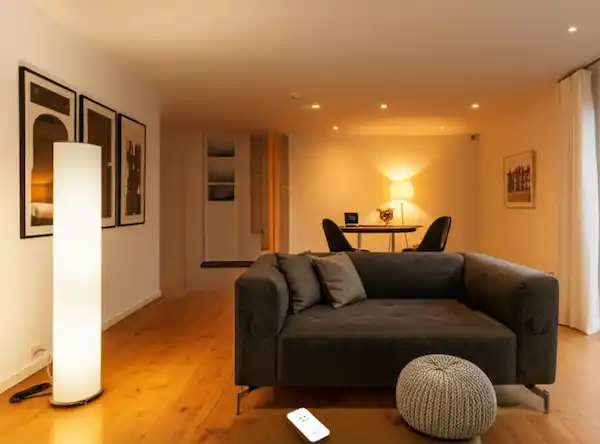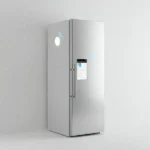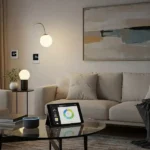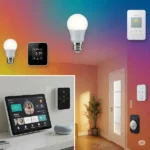Illuminate Your Life: Building Your Smart Home Lighting Control Center
Imagine controlling all the lights in your home with a simple voice command, a tap on your phone, or even having them automatically adjust based on the time of day. This isn’t futuristic fantasy – it’s the reality of a smart home lighting control center. Setting one up can seem daunting, but this guide will walk you through the steps, benefits, and considerations to illuminate your life the smarter way.
Why Build a Smart Home Lighting Control Center?
Before we dive in, let’s consider the perks:
- Convenience: Control all your lights from anywhere using your smartphone or voice.
- Energy Savings: Schedule lights to turn off automatically when rooms are empty or during daylight hours.
- Enhanced Security: Simulate occupancy when you’re away by setting lighting schedules.
- Customizable Ambiance: Adjust brightness and even color temperature to create the perfect mood for any occasion.
- Accessibility: Makes controlling lights easier for individuals with mobility challenges.
Set Up Your Smart Home Lighting Control Center: The Steps
- Choose Your Control Method: The heart of your smart lighting system is how you’ll control it. Here are the main options:
- Smart Hub: A central device that communicates with your smart lights using protocols like Zigbee or Z-Wave. This often offers the most robust and reliable control.
- Wi-Fi Direct: Some smart bulbs connect directly to your home Wi-Fi network and are controlled via a dedicated app. This can be simpler to set up initially but might be less reliable with many devices.
- Voice Assistant Integration: Many smart lights and hubs integrate with popular voice assistants like Amazon Alexa, Google Assistant, and Apple HomeKit, allowing for hands-free control.
- Select Your Smart Lights: Decide which lights you want to make smart. You don’t have to do everything at once! Start with key areas like living rooms, bedrooms, and hallways. Consider the type of fixtures you have and the desired functionality.
- Install Your Smart Lights (and Hub, if applicable): Follow the manufacturer’s instructions for installing your smart bulbs or fixtures. If you’re using a smart hub, connect it to your home Wi-Fi network according to its instructions.
- Connect Your Lights to Your Control Method:
- Smart Hub: Use the hub’s mobile app to “pair” or “add” your smart lights to the system. This usually involves putting the light in a pairing mode and following the app’s prompts.
- Wi-Fi Direct: Connect each smart bulb to your Wi-Fi network through its dedicated app.
- Voice Assistant Integration: Enable the relevant “skill” or “action” in your voice assistant’s app and link it to your smart light or hub account.
- Organize and Customize: Once your lights are connected, most control apps allow you to:
- Name your lights: Be specific (e.g., “Living Room Floor Lamp,” “Kitchen Ceiling Lights”).
- Group lights into rooms or zones: This allows you to control multiple lights simultaneously (e.g., “Turn off downstairs lights”).
- Create scenes: Set predefined lighting levels and colors for different activities (e.g., “Movie Night,” “Reading Mode”).
- Set schedules and timers: Automate when your lights turn on and off.
- Explore advanced features: Some systems offer geofencing (lights turn on/off based on your location) or integration with other smart home devices.
Best Light Fixtures to Use with Smart Lighting
Most existing light fixtures can be made “smart” by simply replacing the traditional bulb with a smart bulb. However, some fixtures are particularly well-suited:
- Recessed Lighting: Ideal for creating uniform ambient lighting that can be easily dimmed and color-adjusted.
- Floor Lamps and Table Lamps: Offer flexibility and can add accent lighting with smart bulbs. Look for lamps with standard bulb sockets.
- Pendant Lights and Chandeliers: Can become statement pieces with smart bulbs, allowing for dramatic lighting scenes.
- Outdoor Lighting: Smart outdoor lights enhance security and can be programmed for automatic illumination.
Possible Different Types of Lights That Can Be Controlled
- Standard A19 Bulbs: The most common type, perfect for lamps and general lighting.
- BR30 Floodlights: Ideal for recessed lighting and spotlighting.
- GU10 Spotlight Bulbs: Used in track lighting and accent fixtures.
- Light Strips/LED Strips: Offer versatile under-cabinet lighting, accent lighting, and even decorative effects with color-changing capabilities.
- Smart Plugs (for Lamps with Standard Bulbs): While not technically a smart light, a smart plug can control power to a traditional lamp.
- Smart Fixtures: Integrated smart lighting solutions with built-in Wi-Fi or other connectivity.
Suggested Brands and Consoles
- Philips Hue: A popular and reliable option with a wide range of bulbs and fixtures. Requires a Hue Bridge.
- Pros: Extensive ecosystem, reliable performance, excellent app.
- Cons: Requires a hub, can be pricier than some alternatives.
- LIFX: Wi-Fi direct bulbs known for their vibrant colors and brightness.
- Pros: No hub required, easy setup, bright and colorful.
- Cons: Can be less reliable than hub-based systems, might strain Wi-Fi network with many devices.
- TP-Link Kasa: Offers a range of affordable smart bulbs and plugs.
- Pros: Budget-friendly, Wi-Fi direct options, good app.
- Cons: Fewer advanced features compared to premium brands.
- Wyze: Another budget-friendly option with smart bulbs and other smart home devices.
- Pros: Very affordable, Wi-Fi direct.
- Cons: Smaller product range compared to established brands.
- SmartThings (Hub): A versatile smart home hub compatible with various Zigbee and Z-Wave lighting brands.
- Pros: Wide compatibility, can control many different types of smart devices.
- Cons: Requires a hub, setup can be more complex.
- Hubitat Elevation (Hub): A local control hub prioritizing privacy and reliability.
- Pros: Local control (works even without internet), strong privacy focus, highly customizable.
- Cons: Steeper learning curve, requires more technical knowledge.
Pros and Cons of a Smart Home Lighting Control Center
Pros:
- Unparalleled Convenience and Control:
- Remote Access: Imagine leaving your house and realizing you left a light on. With a smart lighting system, you can simply open an app on your phone and turn it off from anywhere in the world (as long as you have an internet connection). This is invaluable for peace of mind and energy saving.
- Voice Control: This is perhaps the most captivating aspect for many. Instead of fumbling for light switches in the dark, a simple command like “Alexa, turn on the living room lights” or “Hey Google, dim the bedroom to 30%” provides instant, hands-free control. This is particularly beneficial for individuals with limited mobility or when your hands are full.
- Centralized Management: Instead of individually switching on multiple lights in a room, a smart home app allows you to control entire groups or rooms with a single tap. This streamlines your daily routines.
- Significant Potential for Energy Savings:
- Scheduling and Automation: This is where the real energy savings kick in. You can program lights to automatically turn off when you leave for work, or dim during daylight hours. Conversely, lights can come on automatically at sunset, ensuring you’re not burning electricity unnecessarily during brighter times.
- Motion and Occupancy Sensors: Integrating smart lighting with motion or occupancy sensors means lights only turn on when a room is in use and turn off when it’s empty. This is especially effective in hallways, bathrooms, or utility rooms where lights are often left on accidentally.
- Dimming and Color Temperature Control: Dimming lights uses less energy. Smart lights allow for precise dimming, and the ability to adjust color temperature (e.g., warmer light in the evenings) can also contribute to a more energy-efficient and comfortable environment.
- Enhanced Home Security:
- Simulate Occupancy: When you’re away on vacation, your home can look lived-in, deterring potential intruders. Smart lighting allows you to create “vacation modes” that randomly turn lights on and off at various times, mimicking human presence.
- Integration with Security Systems: Many smart lighting systems can be integrated with smart security cameras or door/window sensors. If a sensor is triggered, certain lights can flash or turn on brightly, drawing attention to a potential issue.
- Exterior Lighting Automation: Smart outdoor lights can be set to turn on automatically at dusk and off at dawn, or triggered by motion, providing illumination for pathways and deterring trespassers.
- Customizable Ambiance and Mood Lighting:
- Color-Changing Capabilities: Many smart bulbs offer millions of color options, allowing you to instantly transform the mood of a room. Imagine setting a vibrant blue for a party, a calming warm white for reading, or a romantic red for a cozy evening.
- Pre-set Scenes: Create “scenes” for different activities. A “Movie Night” scene might dim the main lights and turn on accent lighting, while a “Reading” scene might brighten a specific task light. These scenes can be activated with a single command or tap.
- Dynamic Lighting: Some advanced smart lighting systems can even synchronize with music or movies, creating immersive experiences.
- Improved Accessibility:
- For Individuals with Mobility Challenges: Smart lighting can be a game-changer for those who find it difficult to reach light switches. Voice control or app control provides effortless management.
- Elderly or Visually Impaired: Simplified control and the ability to schedule lights to turn on before entering a room can prevent falls and improve safety.
- Children: Teaching children how to use voice commands for lights can empower them and make bedtime routines easier.
Cons:
- Initial Setup Cost:
- Higher Upfront Investment: Smart bulbs and fixtures are generally more expensive than their traditional counterparts. If you’re outfitting an entire home, the cost can quickly add up.
- Hub Requirement: Many robust smart lighting ecosystems (like Philips Hue) require a dedicated hub, which is an additional cost. While some Wi-Fi direct bulbs eliminate this, they often come with their own set of limitations.
- Professional Installation (Optional): While many DIY, complex setups or integrating with existing wiring might necessitate professional help, adding to the expense.
- Reliance on Wi-Fi Network and Internet Connectivity:
- Network Congestion: If you have many Wi-Fi direct smart devices, they can potentially put a strain on your home Wi-Fi network, leading to slower speeds or connectivity issues for other devices.
- Internet Dependence: Most smart lighting systems, especially those controlled remotely or through voice assistants, rely on a stable internet connection. If your internet goes down, you might lose control over your lights, forcing you to use physical switches (if available) or even making them unusable until the connection is restored.
- Cloud Service Reliance: Many smart home systems rely on cloud servers for functionality. If a company’s servers experience an outage, your smart lights might not work as intended.
- Potential for Technical Issues and Troubleshooting:
- Learning Curve: Setting up and configuring a smart home system can involve a learning curve, especially for those new to smart technology.
- Connectivity Glitches: Like any technology, smart lights can sometimes experience connectivity issues, requiring troubleshooting steps like restarting bulbs, hubs, or routers.
- Software Updates: While updates bring new features and bug fixes, they can occasionally introduce new issues or require recalibration of your system.
- Compatibility Challenges: Ensuring all your chosen smart devices work seamlessly together can be a hurdle, particularly if you mix and match brands from different ecosystems.
- Privacy Concerns:
- Data Collection: Smart home devices, including lighting systems, often collect data on your usage patterns (e.g., when you turn lights on/off, what colors you use). This data is often stored on company servers.
- Voice Assistant Data: If you use voice control, your voice commands are sent to cloud servers for processing. While companies typically anonymize and use this data to improve services, some users have concerns about privacy and potential eavesdropping.
- Security Vulnerabilities: Like any internet-connected device, smart lights can theoretically be vulnerable to hacking if not properly secured, though the risk is generally low for reputable brands.
- Compatibility Issues Between Different Brands and Ecosystems:
- Walled Gardens: Major brands often create “walled gardens” where their devices work best within their own ecosystem. For example, a Philips Hue bulb works seamlessly with a Hue Bridge, but integrating it perfectly with a competing brand’s hub might be challenging or require workarounds.
- Protocol Differences: Smart devices use various communication protocols (Wi-Fi, Zigbee, Z-Wave, Thread, Bluetooth). A hub often acts as a translator between these, but direct compatibility between devices using different protocols can be limited.
- Limited Interoperability: While standards like Matter are emerging to improve interoperability, it’s not yet universal. This can lead to frustration if you want to use a specific feature from one brand with a device from another.
Smart Home Lighting FAQ
- Do I need a smart hub? Not always. Wi-Fi direct bulbs don’t require a separate hub. However, a hub can offer more reliability, wider compatibility, and better performance with a larger number of devices.
- Are smart lights expensive? Prices have come down significantly in recent years, and there are options for various budgets. While some premium brands can be pricey, more affordable alternatives are readily available.
- Are smart lights easy to install? Installing smart bulbs is as easy as replacing a regular bulb. Setting up the control system might require a bit more technical know-how, but most apps provide user-friendly instructions.
- Can I control my smart lights when I’m away from home? Yes, as long as your smart lights and control system are connected to the internet, you can typically control them remotely via their respective apps.
- What happens if my internet goes down? Wi-Fi direct bulbs will likely lose control. Hub-based systems might still allow for local control depending on the hub. Voice control will generally not work without internet.
Conclusion
Setting up a smart home lighting control center is a worthwhile investment that can significantly enhance your daily life. By carefully considering your needs, choosing the right products, and following these steps, you can illuminate your home in a smarter, more convenient, and personalized way. Start small, explore the possibilities, and enjoy the benefits of a truly intelligent lighting system.
Additional helpful information
How to set up a multi-room media center – Set Up a Multi-Room Smart Home Media Center




